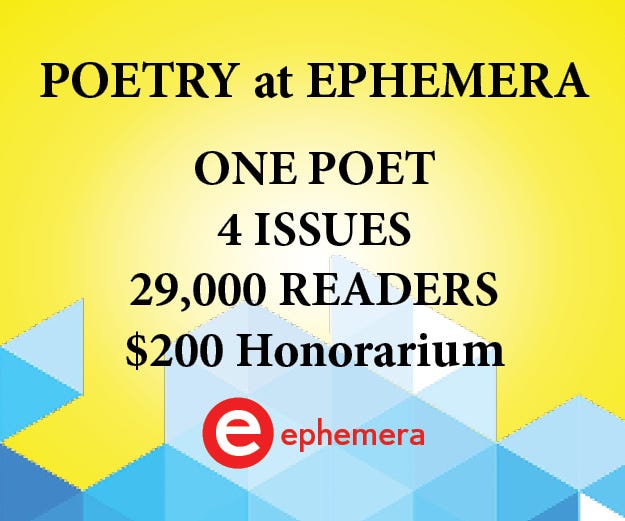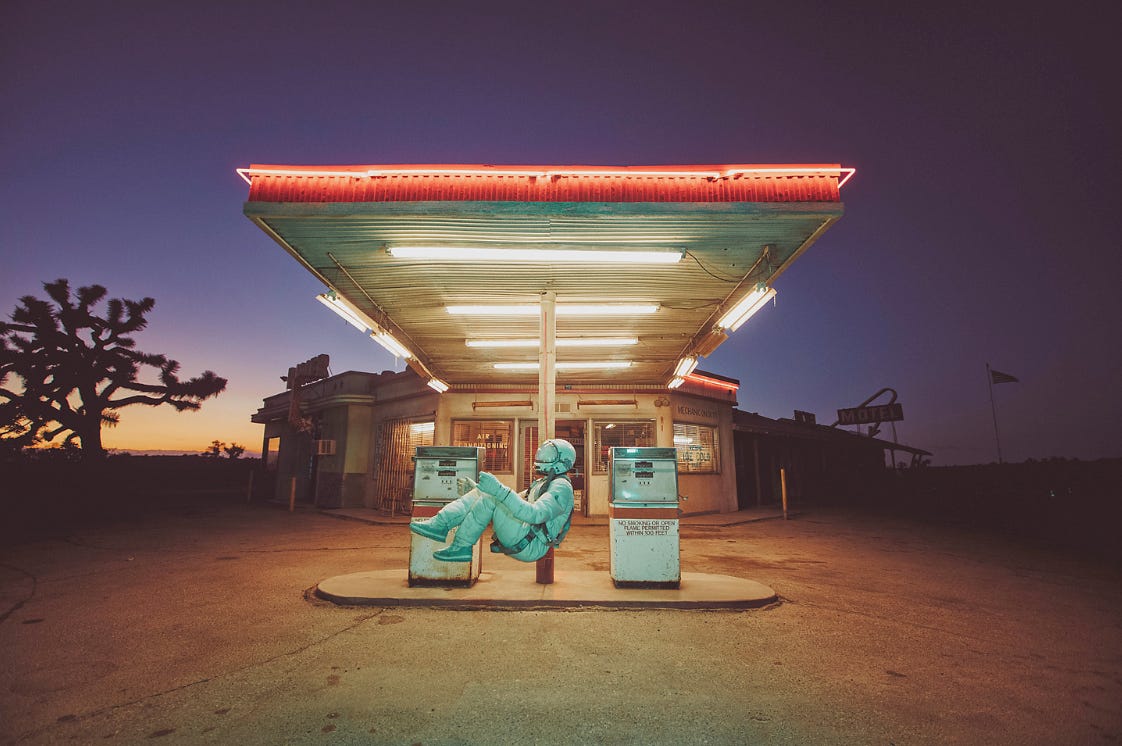Ephemera Newsletter Iss Oct.2
(Creativity and Motivation Weekly)
Welcome to the Ephemera Newsletter free edition, Venner (Norwegian for “friends”)
Poetry October is here with our finalist Jack Stewart whose work will be featured in each issue of October. You can review his poems altogether once they publish as well as artist statement and bio on this dedicated post on our Substack page. We thank you for checking out Jack’s work.
And here are some reminders:
Monthly Invite to Submit: Submissions are in for the November issues. We look forward to reading! We are open for December now. October 30 is the deadline. If you are a paid subscriber to Ephemera, you can submit to poetry @ Ephemera for free as a membership perk! Free subscribers and anyone else can submit, too, with the reading fee and can submit up to 10 poems. Paying the reading fee will grant you 1-month paid access to Ephemera’s full letter. Learn more or:
In Brief…this week’s features:
Thoughts on Karen Jerzyk’s surreal and masterful photography
Listening to Jose Gonzalez’s cover of The Knife’s “Heartbeats”
September’s poet, Jack Stewart’s second of four poems, “A Cup for Ray”
Our weekly lists:
3 magazines with open calls
3 awards/prizes
3 recent job listings for editors and writers.
Interesante:
Book Recs, bonus content, and our mini-essays to start!
Last Week’s Free Issue.
Merci. Danke. Kiitos. 고마워 Go-ma-wo. Cảm ơn. Xiè xiè.
Ephemera
Dear Readers,
We’re up north, from North Carolina to Connecticut we’ve ventured, to a dear friend’s place set on a hill just above a silty section of the Housatonic River with corn fields flanking its banks and a well-wooded hundreds of acres of spruce, oak and maple-turned-orange-and-red. Turkeys cross the property here. They trail each other down hill to access the fields and river. Coyotes, too. Just last night they were howling wildly, in play or for the hunt we did not know. Black bears eat berries along a ridge past a rain pond at the back of the house—it’s the later afternoon when they come around, although the area had its second cold front of the season, which usually sends bears and co scurrying to their dens. We imagined ourselves as natives camped out on a hunt hearing the calls of wilderness. Imagined it filled with wolves and owls and even more night warbles of myriad known and unknown animal beings. How those experiences would have shaped us, our understanding of self and body. How we would have felt in our chests extending to our limbs. Imagine the wayward fur trapper hiked way beyond any settlement settling in for the night adjacent a life-preserving fire. Maybe ghosts aren’t beings but collections of experiences.
Ubi sunt qui ante nos fuerunt?
—Old Latin Saying
Every once in a while it might make sense to become a ghost of sorts. Learn the recorded sensations from our friendly and oft lost vespers and apply them through our bodies and into words as best we can. Everything isn’t about our now-now-then-recent-past body knowledge. Maybe one book, one collection. To know of the many others, past and present, as interpreted by our senses and minds is arguably more important. Empathy through attempts at empathy. We can be with people and listen to them, for sure—which we have discussed—but finding a ghostly space and laying in wait of a wayward apparition, lonely and bereft of voice, never having experienced articulation, maybe, this is a way, too. And so many ways to access our ancestors—we mean that in the deepest sense, the species sense. As we sit on a cold rock ledge, typing gloriously, we can’t help but enjoy the breezy chill for its discomforting effect; we need hardship, however minuscule the dose. Otherwise, the ghosts won’t speak.
Takknemlighet.
(Gratitude)
Poetry by Jack Stewart
A Cup for Ray i.m. of Ray Headen A quarter to six, and I haven’t Even poured my first cup, but amid The emails I will simply delete, There is one with the subject line Sad news and your name, and inside, The words pancreatic and prayers. The birds indistinguishable At this hour will be indistinguishable When the sun is up. The waves In the distance got bored over Their destiny a few millennia ago. But I can barely move. I am going to need coffee with Nothing in it. I am going to have To blink back fate and what burns Like glare. All I can do Is let the steam rise, let the smell In the kitchen drift into other rooms, And pretend there will be other mornings. I have no mirrors for luck. There is no light I can breathe. There are no books worth opening. Sunlight, like someone else’s dog, Will pass the house on the way To nowhere in particular. And I will sit At this table, trying to imagine A useful vocabulary, forgetting To take even a lukewarm sip.
Music: Jose Gonzalez
We love this track, too. Many people first heard Jose Gonzalez’ cover of The Knife’s “Heartbeats” before the original. It’s funny how that works in music and not in writing so much. We don’t do covers, as such. But this is a great one. And for a long time, we didn’t know how Gonzalez came to cover “Heartbeats,” until reading for this section we learned he was born in Sweden. The Knife, too, hail from Sweden and are contemporaries, so it makes sense that Gonzalez knew of the track and, in an interview, described it as being popular with everyone in his local milieu. As the reggae artists Gonzalez grew up listening to took popular tracks and turned them into in-genre covers, Gonzalez took up that tactic with his first album, filling out his EP with the cover, expanding the songs popularity. To this day, it’s often Gonzalez’ version that most people are familiar with, particularly as it has been featured in TV shows and, interestingly, a once-important Sony Bravia commercial for their, at the time, high-tech TV (see below).
“I was inspired by how in Jamaica, if you have a hit, then everybody does it and you have five versions going on at the same time. So in that spirit, I felt it was fun to cover their version. Since it was different, I was also inspired by Johnny Cash and his albums, just taking different popular songs and making them your own.”
—Jose Gonzalez in Guitar.com
Gonzalez’ parents are Argentinian and ended up living in Sweden after fleeing the 1976 coup in their birth country, gaining asylum and raising Jose entirely in their adopted culture. While growing up with Latin influences, Gonzalez also listened to Marley as well as Michael Jackson. He played in several punk and rock bands in the 90s before putting together his first solo record as a singer-songwriter playing acoustic guitar.
We love this cover because it exists in this plane of “is the copy better than the original?” and “the track is so Gonzalez that it’s difficult to see it as a cover.” What is a song that copies enough of another song to be identifiable but sounds so much of a thing unto itself that “cover” doesn’t really do it justice? We’re not sure. But it’s an interesting fourth state of matter, a plasma, perhaps, that is like several things but most alike other things in its rare category. We want to aim for being “plasma” when we homage and borrow (remember to always exquisitely borrow) and rhyme and otherwise build on our predecessors. We want to sound like ourselves so thoroughly that you might not know we’d pilfered anything. But we want to honor the work we’re referencing, particularly at a copying at the level of Gonzalez’ “Heartbeats.” Quote and imitate but make sure we’re honorable, make sure we’ve allowed for the nod to the original.
On a final note, we recommend listening to The Knife’s original in order to fully contrast the two versions. The Knife’s version is more electro and grating in a way, with caustic elements as per their genre. Look at how powerful Gonzalez’ quiet take can be. His is an acoustic guitar and folksy vocals. Theirs is many elements with layering and samples and mixing. There’s something to be said for both—we’ve discussed how many electronic artists sample and use bits and pieces from classical music and classics in rock and pop and soul. Dress down and make it quiet and soulful, or make it wild with pizazz. Either direction can work.
Writers Submit: 2 Magazines
The print and digital journal is a well-liked journal published out of University of New Orleans. They publish in every genre. They continue to focus on both new and established writers. DEADLINE DECEMBER 15
GLASSWORKS
The print and digital magazine is published by Rowan University, which has focused on glass working craft since 1779. The magazine is reading flash and nonfiction for their 26th edition. DEADLINE DECEMBER 15
Weekly Artist: Karen Jerzyk
We’re into these sci-fi and surreal stylized photographs from Karen Jerzyk, who meticulously scouts and curates locations. Intensity of lighting along with emotion are two of the most important aspects of her work, priorities that likely derive from her formative interest in film making, including works from David Lynch, Burton, Kubrick, and Wes Anderson. Born in New Hampshire, and coming to her practice several years after college, Jerzyk is self taught and a bit of a loner; she reportedly had trouble talking with people and instead has sought to “speak” through her artistic work, a characteristic that certainly matches up with many writers.
Keep reading with a 7-day free trial
Subscribe to Ephemera to keep reading this post and get 7 days of free access to the full post archives.


